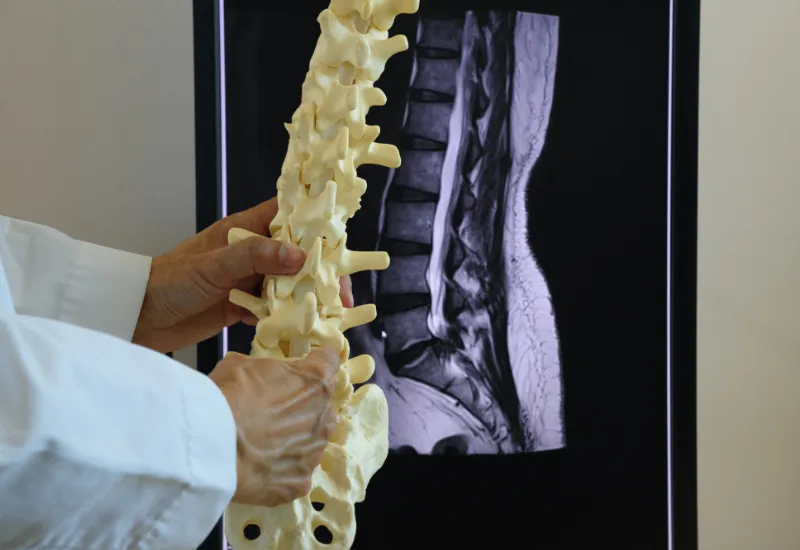A Magnetic Resonance Imaging scan utilizes strong magnets to form anatomical images of the human body without making surgical incisions. An MRI scan can be performed on various organs of the body and allows medical practitioners to view the body's soft tissues such as muscles and organs, in addition to bones, which other diagnostic tests cannot view.
This article focuses on the Lumbosacral Spine MRI: its cost, use, and significance in diagnosis. Let's get right into it!
What is a Lumbosacral Spine MRI?
The human spine comprises 33 bones, known as the vertebrae, divided into five sections:
-
The cervical region
-
The thoracic region
-
Lumbar spine sections
-
The sacrum region
-
Coccyx bones
The lumbar spine sections and the sacrum region of the spin are the two lowest portions of the spine, followed by the coccyx bones, which are present at the end of the spine. The lumbosacral spine comprises the five lumbar vertebral bones (from L1 through L5), the sacrum (which is the bony "shield" at the bottom of the human spine), and the coccyx (which is also known as the tailbone). It also consists of nerves, tendons, ligaments, large blood vessels, and cartilage.
A Lumbosacral Spine MRI focuses on this very portion of the body and examines the area surrounding the spine's lumbar and sacral positions. This is the region where back problems primarily originate from.
What does a Lumbosacral Spine MRI show?
A Lumbosacral Spine MRI is typically prescribed to root out medical complications related to the Lumbar and Sacral regions of the spine. It allows medical professionals to better diagnose and treat spine-related problems such as infection, disease, injury-related pain, swelling, or any other symptoms causing a specific condition.
An MRI of the lumbosacral region also shows the disks, spinal cord, bones, and spaces between the vertebral bones where nerves pass through. The images produced by this scan are high resolution and more in-depth than those produced by ultrasound, X-ray, or CT scans. Doctors typically prescribe this scan to individuals suffering from:
-
Congenital disabilities of the spine.
-
Back pain accompanied by fever.
-
Severe and persistent lower back pain that does not get better with treatment.
-
Multiple sclerosis.
-
Signs of spinal or brain cancer.
-
Tumors in the lower spine.
-
Injury or trauma to the lower spine.
-
Complications related to the bladder.
-
Weakness, numbness, persistent tingling sensation, sciatica, or other problems with the legs.
It is also standard for doctors to order a Lumbosacral Spine MRI if an individual is scheduled for spinal surgery as it allows them to better plan the procedure and make incisions at the required places. High-resolution images produced by an MRI scan of the spine's Lumbosacral region provide information regarding the following:
-
Disc height
-
Alignment of the spine
-
Appearance and alignment of spinal cord
-
Nature of intervertebral disc
-
Vertebrae configuration
-
Compressed nerves
-
Abnormalities near the lower spine
-
Abnormalities after spinal surgery
How much does a Lumbosacral Spine MRI cost?
The prompt pay price for a Lumbosacral Spine MRI with contrast is around $846, and that without contrast is about $664. However, patients generally have to pay a direct pay price of $1,100 and $863 for an MRI with and without contrast, respectively.
A Lumbosacral Spine MRI both with and without contrast is relatively expensive and has a prompt pay price of $1,033 and direct pay price of approximately $1,342. The average pay price of these scans are as follows:
-
Lumbosacral Spine MRI with contrast: $1,692
-
Lumbosacral Spine MRI without contrast: $1,328
-
Lumbosacral Spine MRI with and without contrast: $2,065
However, the price range of this scan depends significantly upon the complexity of a patient's medical condition, the type of the testing center, and the patient's geographical location.
In some cases, there might be additional costs, such as the expense of a mild sedative administered to claustrophobic patients to reduce their anxiety and make them sleepy. Similarly, some individuals are allergic to the Gadolinium contrast dye used in this procedure. Additional charges may apply if radiologists use alternative contrast dyes, such as iodine.
If you are looking to get a Lumbosacral Spine MRI, Cura4U is the most suitable choice for you. Certified medical specialists at Cura4U offer expert quality medical services at exceptional prices. By becoming a part of the Cura4U family, you can schedule any radiology study prescribed by your medical specialist from over 900 radiology centers.
You can also plan any lab test right from the comfort of your home by simply uploading your prescription and getting up to 80% off at 2200 Quest Diagnostic locations around the United States. For example, if you are in Florida, you get a Lumbosacral Spine MRI for as low as $500!
Head over to Cura4U to get to know more about the price range and discount offers in your locality!











